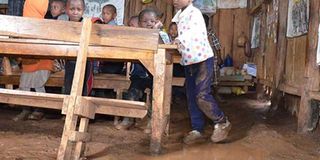School built on wetland crying out for help to save it from collapsing

ECDE pupils at Gatirima Primary School in Marmanet, Laikipia County on July 9, 2018. The school is in urgent need of a makeover as it is currently swamped by water oozing from the middle of the uncemented classrooms. PHOTO | STEVE NJUGUNA | NATION MEDIA GROUP
What you need to know:
- The school, located about 40 kilometres from Nyahururu town, has 412 students and 13 teachers.
- The school has seven blocks of classrooms, five of which were built by parents.
- Mr Mureithi said both the teachers and students have to come to school in gum-boots because of the situation.
Tucked away in the rugged terrain of the semi-arid Laikipia County lies the little-known Gatirima Primary School.
Established in the 1970s by the residents of Laikipia West to quench their children’s thirst for knowledge, it has seen better days and badly needs a makeover.
The school, located about 40 kilometres from Nyahururu town, has 412 students and 13 teachers, who have to make do with its pathetic facilities.
The administration block is in a deplorable state, and the semi-permanent class-rooms, which have earthen floors, are always muddy. The playground looks like a paddy.
FILTHY LATRINES
A foul odour hangs over the compound, and the filthy latrines pose a major health risk to the pupils and teachers.
The construction of one classroom funded by the local Constituency Development Fund has been delayed because the area is swampy, given that it is a wetland.
The school has seven blocks of classrooms, five of which were built by parents while two were donated by the local CDF office in the 2014/15 financial year.
But only one classroom has a cemented floor.
“Our classroom floors have started developing holes as a result of the swampy condition of our school,” Mr Peter Mureithi, the head teacher remarked as he ushered the Nation team into his semi-permanent, mud-floor office.
GUMBOOTS
Mr Mureithi said both the teachers and students have to come to school in gum-boots because of the situation.
“This is the situation we have been in for the last three years. The fact that the school is near a dam that has now started spilling its waters into the school has made the things worse. We are also next to a river that drains its water to Lake Baringo in the neighbouring Baringo County,” he said, adding, “We fear that in a few years’ time, our school will be a swamp.
Mr Simon Kiptisia, the chairman of the school’s board of management, added that the pit latrines have started overflowing, exposing the pupils to more health risks.
“The water levels in the toilets have risen, leading to spillage of sewage onto the fields that our children use as playgrounds, hence exposing them to water-borne diseases,” he said.
His sentiments were echoed by the headteacher, who said some pupils have been missing classes after falling ill.
“Currently, we have several teachers being treated for pneumonia. Pupils have also been getting diseases like diarrhoea, typhoid, and pneumonia, among others,” the head teacher added.
ABSENTEEISM
An early childhood development and education (ECDE) teacher, who sought anonymity, said absenteeism has been a challenge since many pupils frequently miss classes after failing ill.
“Pupils have the hardest time here since the classrooms are muddy. They are exposed to many risks, including diseases and falling since the floor is always slippery,” said the teacher.
He added that he had written a proposal to the Ministry of Education to have the school relocated to a safer ground.
“We also wrote to a contractor working on the Karandi–Muchongoi Road offering to let them dump soil and murram in our school to help raise the ground level but they did not reply,” added the teacher.
He appealed to the county and the national governments to help them improve the school’s facilities.





